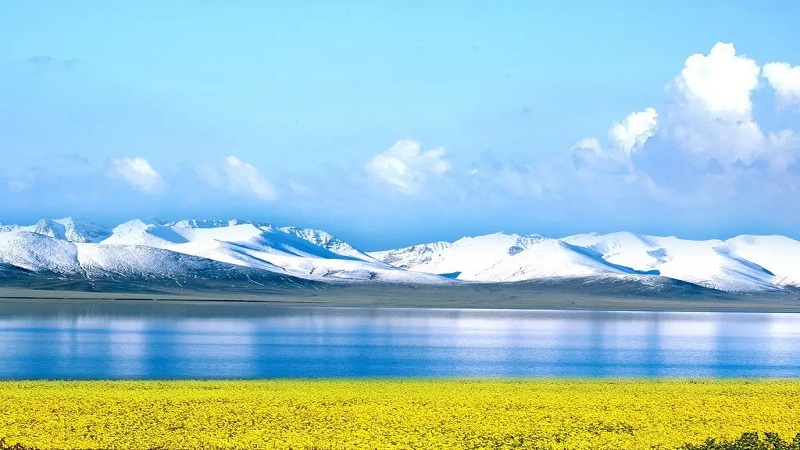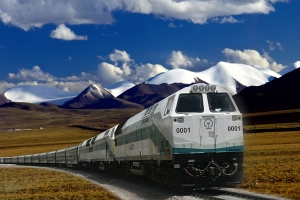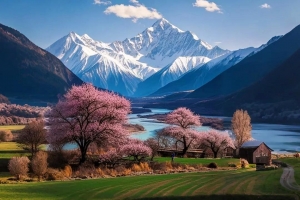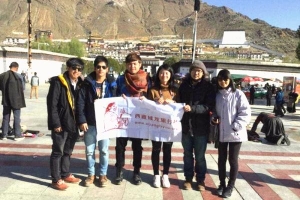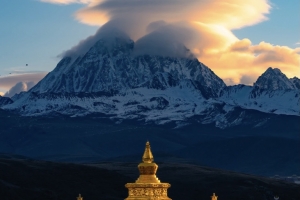The Shanghai–Lhasa train (Z164) departs Shanghai Railway Station each evening at 18:33, winds through eight provinces over roughly 4,373 km, and arrives in Lhasa at approximately 15:05 on day 3. Returning service (Z166) leaves Lhasa at 11:50 and reaches Shanghai about 48 hours later.
This guide delves into every aspect of the Shanghai → Lhasa Z164 sleeper service—from its 4,373 km, 44½-hour journey and detailed station timetable to ticket classes, on-board facilities, cultural insights, seasonal considerations,, FAQs on permits and booking, plus alternative routing via Xining. You’ll learn how to prepare, what to expect at each altitude, when to ride, and how to capture the stunning vistas of the Qinghai-Tibet Railway.
Shanghai to Lhasa Train Route Overview
- Distance & Duration: Approximately 4,373 km in about 44 h 57 min (Z164) Shanghai→Lhasa; ~48 h 13 min (Z166) Lhasa→Shanghai.
- Daily Frequency: One daily pair of trains.
- Altitude Profile: Rises from near sea level in Shanghai (16 m) to peaks above 5,000 m at Tanggula Pass, then settles at 3,650 m in Lhasa.
Detailed Timetable for Z164
| Station | Altitude (m) | Arrival | Departure | Stop Time | Day | Distance (km) |
|---|---|---|---|---|---|---|
| Shanghai | 16 | – | 18:33 | – | Day 1 | – |
| Suzhou | 5 | 19:21 | 19:24 | 3 min | Day 1 | 84 |
| Wuxi | 8 | 19:46 | 19:49 | 3 min | Day 1 | 126 |
| Nanjing | 5 | 21:13 | 21:20 | 7 min | Day 1 | 301 |
| Bengbu | 25 | 22:52 | 22:59 | 7 min | Day 1 | 485 |
| Xuzhou | 36 | 00:18 | 00:28 | 10 min | Day 2 | 649 |
| Zhengzhou | 108 | 03:14 | 03:20 | 6 min | Day 2 | 998 |
| Luoyang | 147 | 04:47 | 04:52 | 5 min | Day 2 | 1,136 |
| Xi’an | 385 | 09:19 | 09:27 | 8 min | Day 2 | 1,509 |
| Xianyang | 479 | 09:42 | 09:44 | 2 min | Day 2 | 1,532 |
| Baoji | 1,314 | 11:00 | 11:08 | 8 min | Day 2 | 1,702 |
| Lanzhou | 1,520 | 16:16 | 16:36 | 20 min | Day 2 | 2,185 |
| Xining | 2,200 | 19:08 | 19:28 | 20 min | Day 2 | 2,401 |
| Golmud | 2,780 | 01:38 | 02:03 | 25 min | Day 3 | 3,231 |
| Amdo | 4,800 | 09:59 | 10:01 | 2 min | Day 3 | 3,661 |
| Nagchu | 4,500 | 10:42 | 10:44 | 2 min | Day 3 | 4,051 |
| Lhasa | 3,650 | 15:05 | – | – | Day 3 | 4,373 |
Tip: Timetable variations occur—always verify on the official 12306 platform before departure.
Shanghai to Lhasa Train Ticket Classes & Pricing
- Soft Sleeper (CNY 1,260–1,310)
Private 4-berth cabins with doors, reading lights, overhead racks, power outlets, and enhanced privacy—ideal for a two-night journey. - Hard Sleeper (CNY 790–840)
Open 6-berth bays with upper/middle/lower bunks; lower berths cost more. Compartment opens directly onto the corridor, so prepare for more ambient noise. - Hard Seat (CNY 400–430)
Bench seating only: the least comfortable choice for overnight travel. If unavoidable, bring your own blanket, neck pillow, eye mask, and earplugs.

Shanghai to Lhasa Train Amenities and Facilities
- The train features a dining car serving three meals a day—Tibetan and Chinese dishes—plus mobile snack trolleys running through the corridors.
- Each carriage end offers free hot water for tea or instant coffee.
- Power outlets are located under lower-berth tables and at corridor stations.
- Soft-sleeper cars have Western and squat toilets; hard-sleeper cars only squat toilets.
- At Golmud (2,780 m), the train’s oxygen system activates automatically: pressurized cabins and individual oxygen inlets beside each berth help mitigate altitude effects.
- Announcements in Mandarin, English, and Tibetan introduce scenic spots, local customs, and safety reminders, enriching the cultural immersion.
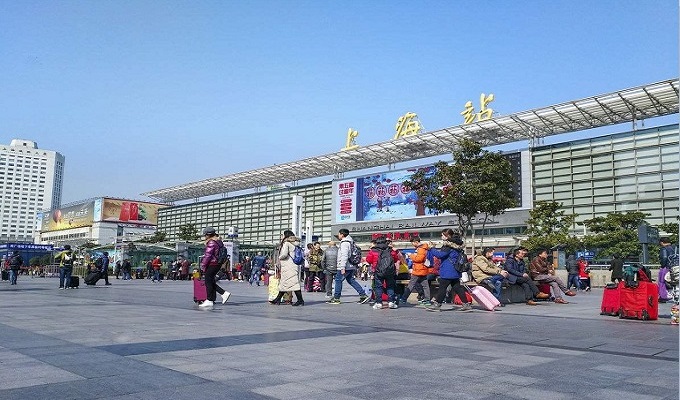
Shanghai to Lhasa Train Seasonal Considerations
- Summer (July–September): Lush grasslands, turquoise lakes, and clear skies make this the most visually striking period.
- Autumn (October–early November): Golden meadows and crisp air; moderate temperatures and fewer crowds.
- Winter (December–February): Stark, snowy landscapes and frozen waterways—photogenic but extremely cold outside the cabin.
- Spring (April–June): Thawing tundra with bursts of wildflowers; variable weather calls for layered clothing.
Shanghai to Lhasa Train Booking & Preparation FAQs
- How far in advance should I reserve?
Book as soon as possible—popular dates and sleeper berths sell out months ahead. - What documents are required?
Both passport and Tibet Travel Permit (obtained via a registered agency at least two weeks prior) are checked before boarding. - How early should I arrive?
Arrive at least 60 minutes before departure for security checks, permit inspection, and ticket-to-bunk-card exchange. - Can I swap berths?
With conductor’s permission, you may swap tickets to stay with friends or family in the same cabin. - What about luggage?
Store large suitcases on overhead racks or vacant shelves; keep valuables and documents under your berth or on your person.
Shanghai to Lhasa Train Scenic Highlights
Most of the Qinghai–Tibet Railway’s signature vistas begin after Xining:
- Jinyintan Grasslands: Endless tundra dotted with grazing yaks and wild antelope.
- Qinghai Lake: China’s largest saltwater lake, shimmering against snow-capped peaks.
- Kunlun & Tanggula Ranges: Towering permafrost passes where the train slows for dramatic views.
- Hoh Xil Reserve: UNESCO World Heritage no-man’s-land, home to kiang (Tibetan wild donkeys) and migratory cranes.
- Nagchu & Cona Lake: Crystal alpine waters in a valley of rolling hills.
- Nyainqentanglha Peaks: Majestic skyline just east of Lhasa, framing the city approach.
Alternative Route for Shanghai to Lhasa: Fly + Train via Xining
To save time and improve ticket availability, consider flying Shanghai→Xining (2 h) and boarding the Qinghai–Tibet train there (≈ 21–24 h).
Xining is the historic starting point of the high-altitude section and offers more daily departures, reducing the risk of sold-out berths.
Contact Journey2tibet to buy soft sleeper tickets for the Shanghai to Lhasa train and start a comfortable train journey in Tibet.
The Shanghai → Lhasa Z164/Z166 train is more than transit—it’s a scenic odyssey across China’s diverse landscapes and cultures, designed to ease altitude acclimation. From booking well in advance, securing permits, and choosing the right berth to photographing plateau wonders, this guide equips you to make the most of one of the world’s most extraordinary rail journeys.


